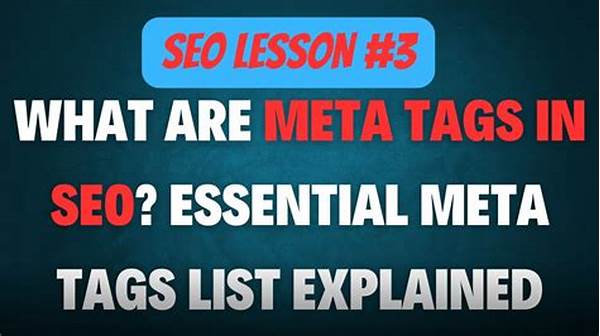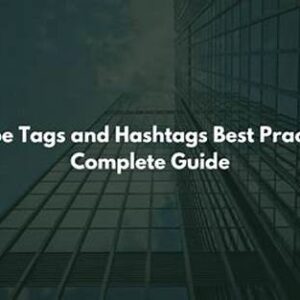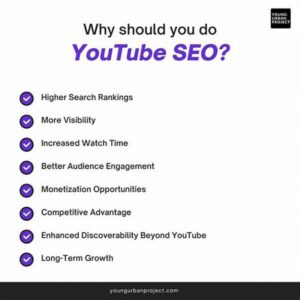The Role of Tags in YouTube SEO Explained
Read More : Youtube Algorithm Explained By Experts
In the ever-changing landscape of digital marketing, video content rightfully claims its throne. But amidst the vast ocean of videos, how do viewers find the content they’re most eager to watch? Enter the strategic use of tags in YouTube SEO. Tags, those seemingly insignificant word clusters, are actually powerful tools. They help creators mark their territory in the vast jungle of YouTube videos. If you’re thinking that tags are old school or somewhat unnecessary, think again. They can be the secret sauce to not just visibility but also viability in the crowded YouTube ecosystem.
Let’s put this into perspective. Imagine you’ve crafted a video that’s the Sistine Chapel of your niche; it has everything the audience could ever wish for—glorious visuals, engaging narratives, and a touch of delightful humor. But without the right tags, it’s like owning the world’s most fabulous painting, but hanging it in your attic. No one sees it, thus no one appreciates it. The role of tags in YouTube SEO explained is like having a golden key that unlocks doors to untapped audiences. These tags communicate a crypto-language to YouTube’s algorithm, whispering sweet nothings that eventually translate to more eyeballs and, ideally, more engagement.
For marketers keen on crafting stories and selling services, ignoring tags in YouTube strategies would be akin to embarking on a journey with half-baked plans. Here’s why they’re pivotal. Tags offer insights into your video’s content, thereby helping YouTube group it with similar pieces. When users hit the search bar or scroll through recommendations, the lines of code sifting through endless data draw from these tags to pair eager watchers with your work. In short, the role of tags in YouTube SEO explained is both strategic and serendipitous.
Why Tags Matter in YouTube SEO
Understanding the dynamics of YouTube SEO can seem daunting. However, the data speak for themselves. According to a study, videos that employ specific and effective tags have a 30% higher chance of being recommended by YouTube’s sophisticated algorithm. That’s a jackpot of potential views waiting to happen, all thanks to a more informed use of tagging.
Content creators who overlook tags can find themselves working tirelessly without seeing the fruits of their labor flourish. But those who master tagging—a potent combination of art and science—often find themselves enjoying better visibility and engagement. The role of tags in YouTube SEO explained adequately can mean the difference between obscurity and prominence in this competitive digital arena.
—
Discussion: Mastering YouTube Tags for SEO Success
Tags are more than keywords; they are the lighthouses guiding viewers to your content. Many creators overlook this critical aspect of YouTube SEO, assuming that other elements such as thumbnails or video quality alone will propel them to visibility. While those elements are undeniably important, tags play a pivotal yet underappreciated role. They provide additional context to the content within your video, helping YouTube’s algorithm categorize and promote your work. Google-owned platforms thrive on rich, layered content—and that includes appropriately tagged videos.
Successful creators understand the power that lies within taking the time to analyze and implement effective tag strategies. They use a mix of broad and narrow tags to optimize their video’s searchability, speaking both to niche audiences and the algorithm. Think of tags like the breadcrumbs in a digital Hansel and Gretel story, cleverly placed to ensure viewers find their way to the treasure trove of your content. The role of tags in YouTube SEO explained is akin to a GPS system in the dense jungle of content forms and categories.
The Science Behind Tagging
Research emphasizes the role of tags in making your content accessible. A study from a leading marketing research institute found that over 70% of the time, videos with tags ended up in “suggested” categories. This is crucial, as suggestions often account for a significant portion of a video’s view count. Implementing the right tags can effectively funnel traffic from similar or related content, capitalizing on trending topics or fan-favorite searches.
The art of mastering tags involves a combination of foresight, industry knowledge, and constant learning. As trends evolve, so should your tagging strategy. Continual adaptation ensures you remain on the cutting edge of searchability. The role of tags in YouTube SEO explained as a dynamic and mutable practice underscores the necessity for creators to stay informed, updated, and adaptable.
Effective Tag Strategies: Start Today
Want to make your videos as discoverable as possible? Then now is the time to perfect your tagging strategy. Begin by identifying the key themes and subjects of your video. Get into the shoes of your audience—what words would they use to find content like yours? Utilize tools like Google Trends or YouTube’s autocomplete function to find popular search terms related to your topic.
Remember, the goal isn’t just to gather more views but the right views. Audiences that are genuinely interested in your content tend to yield better long-term engagement and channel growth. The role of tags in YouTube SEO explained makes evident that quality trumps quantity, even in the scene where everyone seeks to go viral.
—
Uplifting Discussions on “The Role of Tags in YouTube SEO Explained”
Unlock the Potential: Why Tags Are Essential in YouTube SEO
In a digital age defined by content overload, how does one video stand out from the myriad of options? The secret often lies in tapping into effective SEO strategies specific to platforms like YouTube. One such crucial strategy is the clever use of tags. Unlike keywords, which serve more straightforward functions in blog posts and articles, tags in YouTube SEO explained are multifaceted tools that guide the algorithm and serve the audience in equal measure.
Tags help clarify the video’s content and context, assisting the algorithm in elevating it to relevant audiences. This is particularly significant in today’s digital marketplace, where visibility is gold. Videos equipped with precise and descriptive tags are more likely to be placed front and center of potential viewers. Being strategic about the selection and arrangement of these tags can lead to exponential growth in a channel’s visibility and audience engagement.
The role of tags in YouTube SEO explained speaks to the broader narrative of digital marketing—a story that’s constantly being written and rewritten as new trends emerge. As algorithms become more advanced and competition becomes more fierce, creators need to leverage every tool at their disposal. Tags are among the most efficient, cost-effective solutions available, offering a blend of art and science.
Conclusion: The Path Forward for YouTube Creators
As the digital marketplace continues to shift and evolve, the role of tags in YouTube SEO explained becomes ever more critical. For creators looking to maximize their content’s reach, investing time in a thoughtful, data-driven tagging strategy is not just recommended, but imperative. It allows you the essence of choice, targeting your audience smartly and analytically. Whether you’re a beginner or a seasoned creator, understanding the significance of tags within YouTube SEO can make all the difference in elevating your content above the rest and capturing the attention of the audience you wish to reach.




